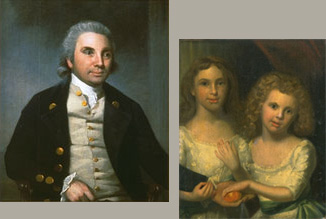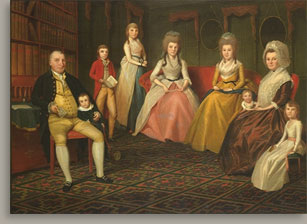 Ralph Earl Ralph EarlCallahan Children, about 1785 Description The younger child stands to the right, with her left shoulder advanced and her head tilted to the viewer’s right. Her hair is lighter brown than the other child’s and is made up of many small curls. She has blue eyes. Like the other girl, she wears a white dress with lace trim, floral pattern, and blue sash at the waist. Her left arm crosses her body, and that hand reaches for the fruit in the hand that enters the painting from the left side of the painting. The younger girl’s right arm is not visible. Earl rendered volumes simply, in nearly geometric forms. Light is implied to fall from the upper left to the lower right. The artist appears to have achieved shadows in the faces by painting yellow and red flesh tones over a gray or brown underpainting. The edges of both girls’ fingers are rendered in dark red to suggest their volume. The background is light in the upper-left corner, darker at the upper center and center-right. The upper-right corner features a red curtain that drapes from top-center to center-right. Biography Although the girls’ identities have not been firmly established, they are likely Mary (1776–1855) and Eleanor Clifford Callahan (1778–1839), who were nine and seven, respectively, in 1785, the year the portrait is thought to have been executed.6 Mary was born in London and died unmarried in Boston. Eleanor was born in Antigua and died, also unmarried, in Groton, Massachusetts. If the proposed date is correct, the children cannot be Abigail (1784–1821) and Lucretia (1788–1838), as family tradition and previous scholars have identified them.7 Analysis The portrait of the father has been cleaned but not the one of his daughters at least in recent times. As a result, John Callahan’s likeness possesses an overall cool tonality, whereas the image of his children is atypically warm due to its yellowed varnish. The location of the fragment containing Lucretia’s portrait is not known.8 The fact that Ralph Earl returned from England in 1785 aboard the Neptune, a ship captained by John Callahan, suggests that the family portrait was painted during the artist’s voyage to America, perhaps in partial passage payment for the artist and his wife.9 An inscription on the John Callahan fragment, apparently written by one of the Callahan children, notes that the painting is By Earl, 1785. [Father was] aged 40 when this was taken.10 That the painting was done on a makeshift support of bed ticking lends further credence to the suggestion that it was made while Earl was in transit. The Callahan portraits are not unique in being painted on such a surface, however. In 1794 Earl painted Major John Davenport and Mrs. John Davenport (both Yale University Art Gallery, New Haven) using that readily available support.11 Other artists occasionally used this material, too, for example, Joseph Badger in his full-length Captain-Lieutenant John Larrabee (about 1750). Among Earl’s fellow passengers on the Neptune was Dr. Joseph Trumbull (1756–1824). An apothecary-doctor who frequently traveled to London to supply his shop in Petersham, Massachusetts, Trumbull sold medicine, surgical instruments, medical books, Bibles and other books, Queens ware, and various imports.12 He and the artist were friends, and Trumbull sat to Earl for his portrait in England in 1784 (Historic Deerfield, Deerfield, Massachusetts). The doctor also was a friend of the Callahans and at one point owned the family portrait under discussion. His will shows that the painting was still intact in 1823:
Although it is not known just when the portrait was cut apart, it probably had been divided by 1903, when a family genealogy recorded that Portraits of Captain Callahan and his wife are now owned by Mrs. Benjamin P. Winslow of Jamaica Plain, Massachusetts.14 Since there is no mention here of the girls’ likenesses, the parts of the painting had probably long since been allocated to different branches of the family.
Earl was more successful at integrating two or three figures in a composition. For example, Mrs. Benjamin Tallmadge and Son Henry Floyd and Daughter Maria Jones (1790, Litchfield Historical Society, Litchfield, Connecticut) builds upon the pyramid formed by the mother’s form and her voluminous skirt. The infant Maria sits on Mrs. Tallmadge’s lap and is mostly contained within the contours of the larger figure. The boy, Henry, sits on the floor, his pose and costume echoing those of his mother. Perhaps the relative insularity of figures in the Callahan family portrait suggested to one of its owners that it could be divided readily and shared among various descendants.15 Notes 2. Oliver and Peabody 1982, 757. 3. Lucretia Greene Callahan diary, 1776–78, manuscript, Massachusetts Historical Society, Boston. 4. As cited in Chandler 1872, 250. 5. Suffolk County Probate Court, Boston, case no. 22870. 6. Clarke 1903, 257–58. 7. See, for example, Sawitzky and Sawitzky 1960, 40; and Kornhauser 1988, 269. For the family tradition that the painting represents Abigail at age ten and Lucretia at seven, see notes kept by Mary Marsh, who was descended from Lucretia and was among the donors of the painting to the Worcester Art Museum, as sent to Laura K. Mills by Henry H. Marsh, September 29, 1998. 8. A second portrait of Mrs. Callahan, by an unidentified artist in oil on panel, is in the collection of the Massachusetts Historical Society, Boston. Oliver 1988, 22. 9. This conjecture was first made in Sawitzky and Sawitzky 1960, 35. Earl’s place on the Neptune is documented by a passenger list published in Salem Gazette, May 24, 1785, and in Thomas’s Massachusetts Spy, Or, the Worcester Gazette, May 26, 1785. The latter source gives May 19 as the date the ship landed in Boston. 10. Oliver 1988, 21. 11. Kornhauser 1988, 279; idem, 1991a, 32. 12. Advertisements, Thomas’ Massachusetts Spy, or, the Worcester Gazette, July 14, 1785, and August 4, 1785. 13. Trumbull will. 14. Clarke 1903, 258. 15. See also Earl’s Mrs. Noah Smith and Her Children (1798, Metropolitan Museum of Art, New York). |


